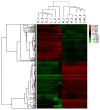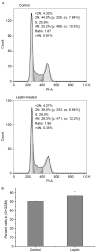Microarray analysis of differentially expressed genes in L929 mouse fibroblast cells exposed to leptin and hypoxia
- PMID: 28534985
- PMCID: PMC5482097
- DOI: 10.3892/mmr.2017.6596
Microarray analysis of differentially expressed genes in L929 mouse fibroblast cells exposed to leptin and hypoxia
Abstract
Leptin and hypoxia are pro-fibrotic factors involved in fibrogenesis, however, the gene expression profiles remain to be fully elucidated. The aim of the present study was to investigate the regulatory roles of leptin and hypoxia on the L929 mouse fibroblast cell line. The cells were assigned to a normoxia, normoxia with leptin, hypoxia, and hypoxia with leptin group. The cDNA expression was detected using an Agilent mRNA array platform. The differentially expressed genes (DEGs) in response to leptin and hypoxia were identified using reverse transcription‑quantitative polymerase chain reaction analysis, followed by clustering analysis, Gene Ontology analysis and pathway analysis. As a result, 54, 1,507 and 1,502 DEGs were found in response to leptin, hypoxia and the two combined, respectively, among which 52 (96.30%), 467 (30.99%) and 495 (32.96%) of the DEGs were downregulated. The most significant functional terms in response to leptin were meiosis I for biological process (P=0.0041) and synaptonemal complex for cell component (P=0.0013). Only one significant pathway responded to leptin, which was axon guidance (P=0.029). Flow cytometry confirmed that leptin promoted L929 cell proliferation. The most significant functional terms in response to hypoxia were ion binding for molecular function (P=7.8621E‑05), glucose metabolic process for biological process (P=0.0008) and cell projection part for cell component (P=0.003). There were 12 pathways, which significantly responded to hypoxia (P<0.05) and the pathway with the highest significance was the chemokine signaling pathway (P=0.0001), which comprised 28 genes, including C‑C motif ligand (CCL)1, C‑X‑C motif ligand (CXCL)9, CXCL10, son of sevenless homolog 1, AKT serine/threonine kinase 2, Rho‑associated protein kinase 1, vav guanine nucleotide exchange factor 1, CCL17, arrestin β1 and C‑C motif chemokine receptor 2. In conclusion, the present study showed that leptin and hypoxia altered the profiles of gene expression in L929 cells. These findings not only extend the cell spectrum of leptin on cell proliferation, but also improve current understanding of hypoxia in fibroblast cells.
Figures



Similar articles
-
A quantitative transcriptomic analysis of the physiological significance of mTOR signaling in goat fetal fibroblasts.BMC Genomics. 2016 Nov 7;17(1):879. doi: 10.1186/s12864-016-3151-y. BMC Genomics. 2016. PMID: 27821074 Free PMC article.
-
Leptin and Pro-Inflammatory Stimuli Synergistically Upregulate MMP-1 and MMP-3 Secretion in Human Gingival Fibroblasts.PLoS One. 2016 Feb 1;11(2):e0148024. doi: 10.1371/journal.pone.0148024. eCollection 2016. PLoS One. 2016. PMID: 26829555 Free PMC article.
-
Identification of key genes and pathways contributing to artery tertiary lymphoid organ development in advanced mouse atherosclerosis.Mol Med Rep. 2019 Apr;19(4):3071-3086. doi: 10.3892/mmr.2019.9961. Epub 2019 Feb 15. Mol Med Rep. 2019. PMID: 30816519 Free PMC article.
-
Transcriptome profiling of the newborn mouse lung after hypoxia and reoxygenation: hyperoxic reoxygenation affects mTOR signaling pathway, DNA repair, and JNK-pathway regulation.Pediatr Res. 2013 Nov;74(5):536-44. doi: 10.1038/pr.2013.140. Epub 2013 Sep 2. Pediatr Res. 2013. PMID: 23999071
-
Topological network analysis of differentially expressed genes in cancer cells with acquired gefitinib resistance.Cancer Genomics Proteomics. 2015 May-Jun;12(3):153-66. Cancer Genomics Proteomics. 2015. PMID: 25977174
Cited by
-
ROCK Inhibition as Potential Target for Treatment of Pulmonary Hypertension.Cells. 2021 Jun 30;10(7):1648. doi: 10.3390/cells10071648. Cells. 2021. PMID: 34209333 Free PMC article. Review.
-
Altered expression of differential gene and lncRNA in the lower thoracic spinal cord on different time courses of experimental obstructive jaundice model accompanied with altered peripheral nociception in rats.Oncotarget. 2017 Nov 20;8(62):106098-106112. doi: 10.18632/oncotarget.22532. eCollection 2017 Dec 1. Oncotarget. 2017. PMID: 29285317 Free PMC article.
-
Hypoxia Alters the Expression of CC Chemokines and CC Chemokine Receptors in a Tumor-A Literature Review.Int J Mol Sci. 2020 Aug 6;21(16):5647. doi: 10.3390/ijms21165647. Int J Mol Sci. 2020. PMID: 32781743 Free PMC article. Review.
-
Nedd4L suppression in lung fibroblasts facilitates pathogenesis of lung fibrosis.Transl Res. 2023 Mar;253:1-7. doi: 10.1016/j.trsl.2022.10.002. Epub 2022 Oct 17. Transl Res. 2023. PMID: 36257596 Free PMC article.
References
-
- Peters S. Cystic fibrosis: A review of pathophysiology and current treatment recommendations. S D Med. 2014;67:148–151. 153. - PubMed
MeSH terms
Substances
LinkOut - more resources
Full Text Sources
Other Literature Sources
Research Materials
Miscellaneous

